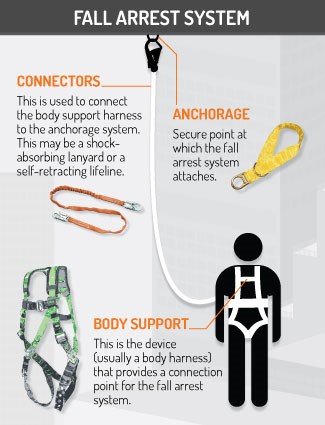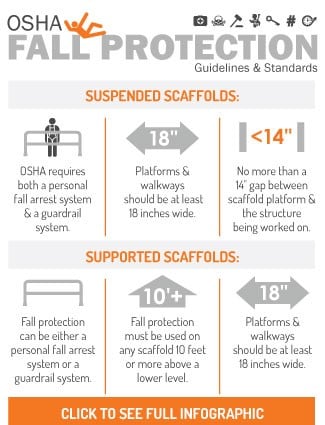OSHA Scaffolding Standards: Essential Fall Protection Resources

In November 2013, a Massachusetts roofer fell to his death while working on a condominium. An OSHA investigation found that his employer failed to provide fall protection and scaffolding guardrails. The equipment would have prevented the fall and saved the man's life.
Tragedies like this are far too common, especially on construction sites. Ineffective or missing fall protection accounted for 40% of all construction deaths in 2014, and it is among OSHA's most common citations every year.
Scaffolding is among the most versatile and effective tools for erecting or maintaining structures. Yet that versatility and mobility demands caution, safety, preparation, and effective fall protection.
Here's a look at how to keep workers safe and comply with OSHA standards for scaffolding safety.
Personal Fall Arrest Safety
 Personal fall arrest systems are one of two types of fall protection typically required on scaffolds. These generally include some combination of a harness, D-rings, snap hooks, lifelines, and an anchorage point. Here's a quick breakdown of general requirements for personal fall arrest systems:
Personal fall arrest systems are one of two types of fall protection typically required on scaffolds. These generally include some combination of a harness, D-rings, snap hooks, lifelines, and an anchorage point. Here's a quick breakdown of general requirements for personal fall arrest systems:
- Personal fall arrest systems must attach to a vertical lifeline, horizontal lifeline, or scaffold structural member via a lanyard.
- Vertical lifelines must fasten to a fixed anchorage point, independent of the scaffold, and must be protected from sharp edges and abrasion.
- Safe anchorage points include structural members of buildings. Standpipes, drain pipes, vents, electrical conduits, and similar objects are not structural parts of the building and, as a result, are never safe anchorage points.
- Two or more vertical lifelines may not attach to each other, nor to the same point of anchorage.
Guardrail Safety
Guardrails are another form of fall protection. Here's a brief look at general requirements for guardrails:
- Guardrails must cover all open sides and the ends of the platform. Top rails, midrails, screens, mesh, intermediate vertical members, and solid panels must withstand a force of at least 150 pounds applied in any downward or horizontal direction.
- Toprails on scaffolds created and used after January 1, 2000, must be between 38 and 45 inches tall. Toprails for scaffolds created and used before that date may be between 36 and 45 inches tall.
Fall Protection on Suspended Scaffolds
 Suspended scaffolds are platforms suspended by cables, ropes, or other non-rigid methods from an overhead structure. Window washers on skyscrapers usually work from suspended scaffolds, but construction workers also use them on extremely tall structures.
Suspended scaffolds are platforms suspended by cables, ropes, or other non-rigid methods from an overhead structure. Window washers on skyscrapers usually work from suspended scaffolds, but construction workers also use them on extremely tall structures.
OSHA generally requires a personal fall arrest system or guardrail system for workers on suspended scaffolds 10 feet or higher above a lower level. However, employees on single-point and two-point adjustable suspended scaffolds must use both a personal fall arrest system and a guardrail.
Fall Protection on Supported Scaffolds
Supported scaffolds include one or more platforms supported by poles, legs, uprights, outrigger beams, posts, frames, or other types of rigid supports.
Employees must use a personal fall arrest system or a guardrail system on supported scaffolds 10 feet or higher above a lower level.
Horizontal lifelines must be anchored to two or more structural members of the scaffold.
Guardrail systems must be installed along all open sides and ends of platforms. Midrails and toe boards are also required, unless workers always use a personal fall protection system.
Other Types of Scaffolds
Supported and suspending scaffolds are just two of the many forms of scaffolding. Here's a quick breakdown of OSHA fall protection requirements for other types of scaffolding.
- Aerial lifts, boatswains' chair, catenary scaffold, float scaffold, ladder jack scaffold, and needle beam scaffold: Employees must use a personal fall arrest system.
- Crawling board: Employees must use a personal fall arrest system, guardrail system, grabline (with a 3/4-inch diameter), or equivalent handhold fastened beside each crawling board.
- Self-contained scaffold: Workers must use both a personal adjustable scaffold arrest system and a guard rail system.
- Other forms of scaffolding: Employees must use a personal fall arrest system or a guardrail system.
Safe Scaffolding Resources and Solutions
OSHA estimates that protecting workers from scaffold-related accidents could prevent up to 50 deaths every year. To prevent injury, visit Duralabel's PPE Signage page, which includes fall protection signage, fall kits, harnesses, anchorage, lanyards, and lifelines. Check out our selection of fall protection signs.
Related Resources

OSHA and Ironworkers Partner for Safety Outreach
OSHA and Ironworkers are partnering up to help boost safety programs and prevent the most common injuries, ...
Read
Stand-Down Underscores Importance of Fall Protection
OSHA's National Safety Stand-Down, happening May 4-8, 2020, works to minimize the number of workplace falls ...
Read
OSHA Regulations for Fall Protection and Compliance Standards
What Are OSHA Regulations for Fall Protection? Occupational Health and Safety Administration(OSHA) ...
Read.png)





